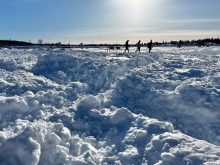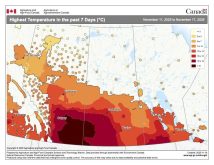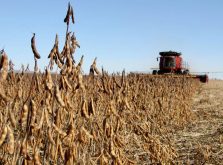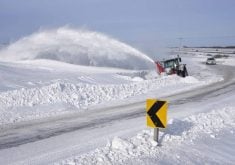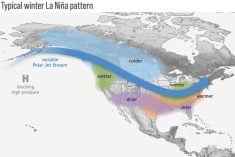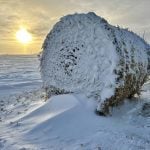In the last Meteorology 101 class, we introduced the four main forces that drive our winds: gravity, air pressure, Coriolis and friction. This week we will go into more detail to better understand what creates wind.
Without gravity, there would be no weight to the atmosphere, and without weight there would be no air pressure. Now let’s focus on the forces of pressure gradient, Coriolis and friction, and how they interact to create wind.
Pressure differences exist in our atmosphere due to unequal heating of Earth’s surface. Cold air is dense and will exert greater pressure than warm air. We show or measure the strength of a pressure gradient on a map by drawing isobars or isolines. These are lines on a map that connect areas of equal pressure.
Read Also

Predicting Manitoba winter snowfall
How much snow should farmers in Manitoba expect for the rest of December 2025 and into January-February 2026? Here’s what the weather models say about the winter to come.
The spacing between the isobars tells us the intensity of the pressure gradient force. Close spacing indicates a steep gradient, while wide spacing is equal to a light or gradual gradient.
If we take a simple look at Earth, the polar regions would have high pressure because they are cold, and the equatorial regions would have low pressure because they are warm.
The air would then move directly from north to south at right angles to the isobars. But we all know this is not always the case. The question is, why not? The answer lies with the next two forces: Coriolis and friction.
Basically, the Coriolis force arises because Earth rotates. Anything that flies or flows across Earth’s surface (wind, airplanes, ocean currents) will be deflected from a straight path because of that rotation.
In the Northern Hemisphere, things are deflected to the right of their intended path, and to the left in the Southern Hemisphere. The Coriolis force is weakest at the equator and strongest around the poles.
The amount of deflection from the Coriolis force is also controlled by the speed of the object that is moving — the greater the speed, the greater the deflection.
So, on our simple Earth, air flowing from high pressure at the North Pole toward low pressure at the equator would be deflected to the right, eventually flowing parallel to the isobars.
We would typically find this type of air flow in the upper atmosphere, but we don’t see it near the Earth’s surface. Why?
Well, we have our last force to deal with: friction.
Friction between the wind and Earth’s surface varies depending on the type of surface. Typically, frictional forces will affect winds to an altitude of about 500 metres. Friction decreases the speed of the wind, reducing the effect of the Coriolis force.
Instead of the wind blowing parallel to the isobars, it blows at an angle. The net effect is that winds blowing from areas of high pressure tend to spiral outward, and spiral inward as they move toward low pressure.
With this knowledge, we can start piecing together the bigger picture of global winds, or what is referred to as general atmospheric circulation.
Strong sunshine along the equatorial regions results in warm rising air and a region of low pressure, or what is known as a thermally created area of low pressure. At the poles, the low amount of sunshine results in cold, heavy air that sinks, and this results in an area of high pressure or a thermally created high.
If the Earth didn’t rotate, our lesson would be coming to an end.
Fortunately, our planet does rotate, creating a more complex pattern of global winds. The flow of air moving from the North Pole toward the equator would be deflected to the west, eventually resulting in all the winds blowing from east to west.
Contents under pressure
If you live in the high Arctic or in the tropics, you have no problem with this picture, because prevailing winds are easterly in these regions. Here in our neck of the woods, we are probably scratching our heads, because our winds don’t seem to follow this scenario. Our prevailing winds blow from west to east.
What’s up? Obviously, something more is going on with the atmosphere. Our simple picture of thermally induced low pressure at the equator and high pressure at the poles needs a couple more regions of low and high pressure added to it. These two new regions are known as dynamically induced areas of high and low pressure.
Dynamic high- and low-pressure regions are created by mechanically forcing air to either rise or sink. The first of these regions are the subtropical highs. These are the desert regions of the Northern Hemisphere.
As warm air rises at the equator, it has to spread out. As it flows northward, it gets mechanically or dynamically pushed downward, and is compressed and heated. Once this air reaches the ground, it spreads out once again. Some air returns toward the equator and some heads north toward the poles. It is this northerly flow of air out of the subtropical high that gives us our westerly winds.
The second dynamically produced region is an area of low pressure known as the subpolar low. This region of general low pressure is located around 60 degrees latitude. Much like the subtropical high, this area of low pressure is formed when the air flowing northward from the subtropical high (the westerly winds) bumps up against the southward flowing polar air. This forces the air to move upward, creating low pressure.
In our next lesson, we will focus on subtropical highs and polar lows, to understand how these combine to create the weather we experience daily.




